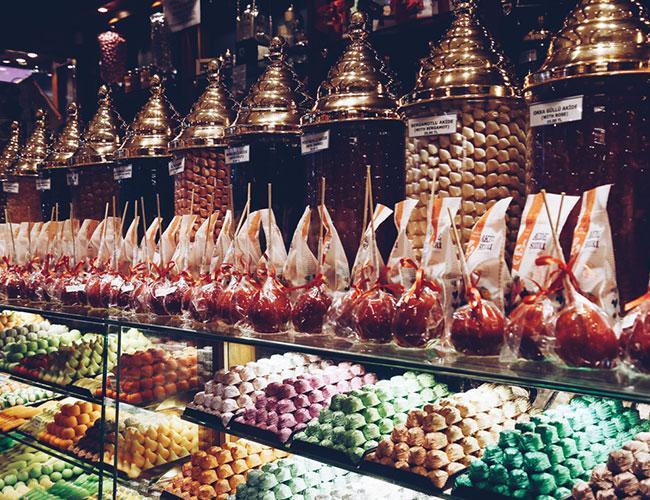Sugar power
Aylin Öney Tan - aylinoneytan@yahoo.com

Fondness for sweetness is surely the weakness of mankind. Once hooked to the seductive sweet taste, it is hard to wean oneself from the comforting cradle of sweetness. However, sugar was a rarity in Europe for centuries. In history, sugar was long obtained from sugar cane, originally produced in the Indian subcontinent since ancient times. During the Indian Campaign of Alexander the Great, his officer Nearchus wrote of sugar cane as “reed giving honey without bees.” Crusaders described it as “sweet salt” and brought the stuff to Europe while the Arabs had already introduced sugar to Sicily by the 10th century, establishing sugar mills on the island.
Before the advance of sugar manufacture in Europe, sugar made from cane had to be mostly brought from faraway colonies, so it always remained as an expensive luxury item. Sugar cane could only be grown in tropical and subtropical zones and in some parts of the Mediterranean such as Sicily, Cyprus and Egypt. In search for producing a sugar from an alternative crop suited to European climate led to several researches and the winner was Beta vulgaris, the sugar beet. Sugar was first successfully isolated from beetroot in 1747 in Silesia; further selections were made to create the beet with the highest sugar content and eventually white Silesian sugar beet was the new ideal crop. However, industrial sugar manufacture did not take off until the early 19th century. It happened only after the bitter crisis between the British and the French when British fleets implemented a tight blockade to cut off France from importing goods. Eventually, Napoleon decided to produce French sugar as a reaction to the blockade, not to be dependent on sugar from afar. Sidney Mintz, author of the colossal book “Sweetness and Power,” summarizes the existence of sugar in Europe as: “1650 hardly known, 1750 a luxury item.1850 a necessity.”
The Turkish sugar story can be likened to the French case. Deprived from its usual sugar sources, the country needed to create a new plan. During the Ottoman times sugar was considerably plenty and was an item of internal trade. Most of the sugar that came to Istanbul was from Cyprus, Palestine or Egypt, all former Ottoman lands. For the bigger masses if sugar was expensive there was plenty of honey or pekmez, molasses made from grape of sweet white mulberry, all used extensively in the kitchen as very common sources of sweetness. During the decline of the Ottoman Empire, it lost a considerable portion of its territory within the lapse of 19th century. The losses included Cyprus in 1878, Egypt in1882 and lastly Palestine in 1918. That meant no more sugar coming to the sugar-addict city of Istanbul. There had to be new sources and with the establishment of a railway between mid-Europe and Istanbul, the new route was from Europe. The first train from Vienna to Istanbul was in 1888, soon after 40 wagon loads of sugar was imported. Of course, carrying sugar from Europe was not feasible and sustainable, yet the empire was falling apart.
After the War of Independence, the newly established Turkish Republic had to come up with a solution. The İzmir Economic Congress held in 1923, even before the official declaration of the Turkish Republic, gave the start. The conference was held in order to emphasize on the importance of Turkish economic development as the country had been shattered by years of war. The congress was comprehensive with around 3,000 delegates putting forward their priorities with four main working groups consisting of farmers, merchants, industrialists and workers. Early Turkish economic policy was to be articulated at this congress.
In his opening speech, Mustafa Kemal Atatürk, founder of modern Turkey, addressed the importance of winning the economic battle, now that the military battle had been won, the victory will only complete with economic independence. He stressed the fact that the reason of the decline and crumbling of the Ottoman Empire was due to its economic failures. His motto was sovereignty could only be achieved by economic independence and being a self-sustained country.
The message was taken. The first initiative came from a group of farmers from the western province of Uşak. They used their own funds to found their first sugar factory; eventually the first two sugar factories were almost simultaneously opened in Alpullu, Thrace and Uşak, just east of İzmir, with several others to follow. The sugar factories became state establishments bringing advanced agriculture, industry, employment, and above all culture to underdeveloped parts of the country. Wherever they were founded, they spearheaded progress, bringing schools, farmer training and social activities such as movie theatres in their wake. One retired employee called this spirit “şeker terbiyesi.” This expression is a play on words as it can be translated both as “marinated in sugar” and as “sweet manners.” The country was no longer dependent on foreign sugar.
According to FAO, today Turkey ranks as the sixth largest beet sugar producer in the world, following Russia, Ukraine, Germany, France, and the United States. The sweet success of sugar-power that started by the İzmir Economy Congress in 1923 now has another turn. But alas, no fairy story has a happy ending in real life. We, in this country, are great creators of our own miracles and disasters alike. Now with the privatization of sugar factories, the sweetest story of recent history may turn bitter, very bitter indeed. The power of sugar will no longer be in the hands of the people.
Fork of the Week: Eid al-Fitr, known in Turkey as Ramazan Bayramı, is also referred to as Şeker Bayramı, meaning Sugar Holiday. This is the time to indulge in sweets and candies. Head for the Cafer Erol shop in Kadıköy and lose yourself in the amazing range of sweets they have, from lokum (Turkish delight) to akide (hard candy), but do not forget the candied fruits. My favorite remains the unripe whole walnut, but don’t forget the jewel-like mandarins and deep green figs.
Cork of the Week: When indulging in sweet things, best to pair your guilt with sweet wines. Though Turkey is not particularly known for its sweet wines there are newcomers in the market with exceptional quality. Madre by Kayra and Mahlep by Diren are the usual good old choices; newcomers in the market include a sublime Passito by LA from Bornova Muscat grapes. But this time try something different: Çamlıbağ Şarap Likörü Mistel 2006 by Yunatçılar from Bozcaada. If you cannot get hold of a bottle, remember that Yeni Lokanta in Beyoğlu stocks both Mistel and Passito, a wonderful opportunity to indulge in their wonderful range of sweets.












